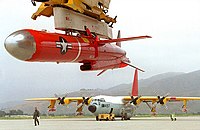
Photo from wikipedia
The Internet of Underwater Things (IoUT) plays a key role in maritime monitoring systems, but energy-efficient data-uploading has been a challenging task owing to energy-constrained and expensive facilities, such as… Click to show full abstract
The Internet of Underwater Things (IoUT) plays a key role in maritime monitoring systems, but energy-efficient data-uploading has been a challenging task owing to energy-constrained and expensive facilities, such as buoys and underwater sensors. In this article, we present an energy-efficient data collection scheme for unmanned aerial vehicle (UAV)-aided ocean monitoring networks (OMNs), where underwater acoustic and aerial radio frequency (RF) links are considered collaboratively. Our goal is to maximize energy efficiency (EE) of the entire OMN by jointly optimizing the transmit power of buoys and sensors, scheduling their transmissions, as well as designing the UAV's trajectory; the objective function is constrained by minimum throughput thresholds, power consumption budgets, and the UAV's kinematic conditions. Furthermore, we introduce a tradeoff between the energy consumption of buoys and sensors to bridge the gap between acoustic and RF links. The formulated problem is decomposed into three subproblems and they are solved alternatively. In each iteration, we leverage Dinkelbach's method and successive convex approximation (SCA) technique to tackle the fractional program (FP) and transform an original subproblem into a convex form, respectively. Extensive simulations confirm the convergence of our proposed scheme, reveal the influence of the tradeoff on EE, and show that our scheme outweighs other benchmarks in different scenarios.
Journal Title: IEEE Internet of Things Journal
Year Published: 2022
Link to full text (if available)
Share on Social Media: Sign Up to like & get
recommendations!